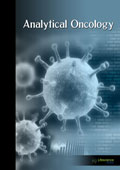jao
|
|
Abstract: Triptolide is a bioactive natural products isolated from Tripterygium wilfordii, a traditional Chinese herbal medicine. Clinical studies reveal that triptolide can be used in autoimmune disorders, such as rheumatoid arthritis, kidney disease and systemic lupus erythematosus. Recently, some studies revealed that triptolide has anti-tumor effects, which attracts more and more attention. This experiment aimed to explore the relationship between anti-tumor effects of triptolide and N-type polylactosamine. With increasing the concentration of triptolide, the viability of MCF-7 and HepG2 cells was reduced significantly and the polylactosamine expression on these cells declined as well. In addition, the expression of β1, 3-N-acetylglucosamine transferase (β3GnT8) participated in catalyzing the synthesis of N-type polylactosamine was also decreased and the expression of genes and proteins of downstream signaling was altered consequently. Finally, triptolide weakened the cancer cells invasion and migration. All of these indicate that triptolide can impair MCF-7 and HepG2 cells invasion and migration through downregulating the expression of polylactosamine chains. These studies establish that triptolide is a potential novel therapy in breast cancer and hepatic carcinoma. Download Full Article |
|
|
Abstract: Objective: To investigate tobacco consumption induced changes in the in vivo Raman spectra of oral mucosa of healthy volunteers and to study its effect on the differential diagnosis of oral lesions. Materials and Methods: The clinical in vivo study involved 28 healthy volunteers and 171 patients having malignant and potentially malignant lesions of the oral cavity. Twenty of the healthy volunteers had habits of either smoking and/or of chewing tobacco while the rest did not have any tobacco consumption habits. The in vivo Raman spectra were measured using a compact and portable near-infrared Raman spectroscopic system. A probability based multi-class diagnostic algorithm, developed for supervised classification, was employed to classify the whole set of measured tissue Raman spectra into various categories. Results: It was found that the Raman spectra of healthy volunteers with tobacco consumption habits could be separated from the spectra of those without any habit of tobacco consumption with an accuracy of over 95%. Further, it was found that exclusion of the spectral data of the oral cavity of the healthy volunteers from the reference normal database considerably improved the overall classification accuracy (92.3% as against 86%) of the algorithm in separing the oral lesions from the normal oral mucosa. Conclusion: The results of the clinical study demonstrate the potential of Raman spectroscopy in screening tobacco users who are at an increased risk of developing dysplasia or malignancy. Further, the results also show that for accurate discrimination of oral lesions based on their Raman spectra, the reference normal database should exclude spectral data of tobacco using healthy subjects. Download Full Article |
|
|
Abstract: Breast cancer develops in an adipose rich environment of normal adipocytes that are known to aid in tumor progression through an unknown method of lipid transfer from normal cells to tumor cells. Much research is built around lipid analysis of breast tumor and adjacent normal tissues to identify variations in the lipidome to gain an understanding of the role lipids play in progressing cancer. Ideally, single-cell analysis methods coupled to mass spectrometry that retain spatial information are best suited for this endeavor. However, many single-cell analysis methods are not capable of subcellular analysis of intact lipids while maintaining spatial information. One-Cell analysis is a true single-cell technique with the precision to extract single organelles from intact tissues while not interfering or disrupting adjacent cells. This method is used to extract and analyze single organelles from individual cells using nanomanipulation coupled to nanoelectrospray ionization mass spectrometry. Presented here is a demonstration of the analysis of single lipid bodies from two different sets of breast tumor and normal adjacent tissues to elucidate the fatty acid composition of triglycerides using One-Cell analysis coupled to tandem mass spectrometry. As a result, thirteen fatty acid species unique to the tumor tissues were identified, five in one set of tissues and eight in the other set. Download Full Article |
|
|
Abstract: Numerous studies show that prevalence of prostate cancer (PCa) drastically increases with age, these malignant tumours are mainly formed in the peripheral zone of the prostate gland, and a high intake of red meat is associated with a statistically significant elevation in risk of PCa. The factors which cause all these well-specified features of the PCa are currently unclear. Here we describe one factor which can play an important role in etiology of malignant transformation of the prostate and is connected with the above-mentioned features of PCa. It is hypothesized that the prostatic intracellular Zn concentrations are probably one of the most important factors in the etiology of PCa. For an endorsement of our standpoint the estimation of changes of intracellular Zn concentrations over males’ lifespan was obtained using morphometric and Zn content data for the peripheral zone of prostate tissue, as well as Zn concentration in prostatic fluid. It was shown that the Zn concentrations in prostatic cells for men aged over 45 years are 10-fold higher than in those aged 18 to 30 years and this excessive accumulation of Zn may disturb the cells’ functions, resulting in cellular degeneration, death or malignant transformation.We hypothesize this excessive intracellular Zn concentration in cells of the prostate gland periphery has previously unrecognized and most important consequences, associated with PCa. Download Full Article |
|
|
Abstract: We present a documented case report of lumbar vertebral osteomyelitis after transrectal biopsy (TRUSB) complicated by sepsis due to Escherichia coli. The Images and histological examination showed an every day more frequent complication. We review the methods of diagnosis and treatment and compare with the scarce literature. Download Full Article |



